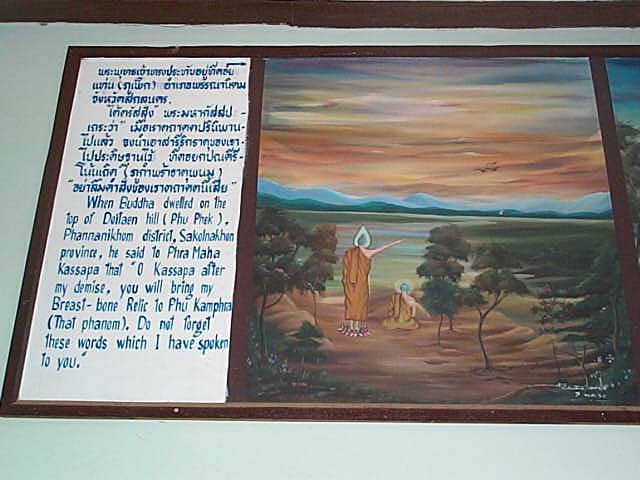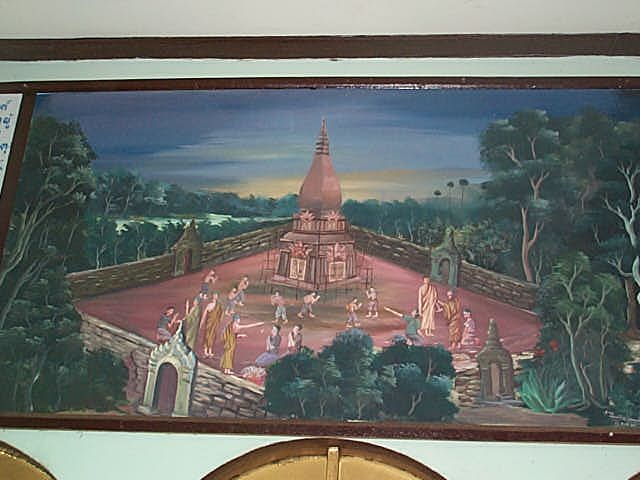
Nakhon Phanom Chedi
Nakhon Phanom Chedi may be the oldest Buddhist memorial and temple in Thailand. It is located next to the Mekong River in the far northeast in the province of Nakhon Phanom. I travelled there for the first time in March, 2001. The main things I found there were totally uncovered in the tour books which I had read, and a search of the Internet using google.com at that time turned up little. So, below are some photos and information from my visit, but first the history:
The original chedi was built 8 years after the Buddha passed away, which is 535 B.C., i.e., over 2500 years ago. However, additional construction was built on top of it and around it at later times.
535 B.C. (Before Christ), or 8 B.E. (Buddhist Era):
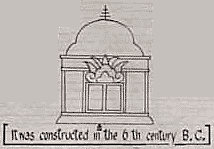
Approx. 0 B.C., or
500 B.E.:
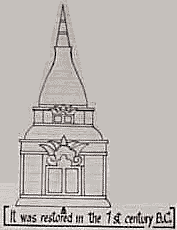
1609-1692 A.D.
2152-2235 B.E.:

1941-42 A.D.
2484-5 B.E.:

The Chedi is of the Lao shape and style.
Speculation on the existence and whereabouts of Buddhist "relics" (i.e., the bones of The Buddha) has not been encouraged, and this in understandable in view of past military conquests to steal them, as well as the absconding of some of the best Khmer and Thai archaeological artifacts which are now not in Thailand but in museums around the world and in "private collections". Wise men don't discount the potential of future armies, local corruption or future theft technology. For example, the Taliban in Afghanistan in 2001 destroyed giant Buddhist statues carved into sandstone cliffs 1500 years ago, the destruction based on self-righteous, bigoted and negatively destructive religious dogma.
It is now well known on the internet that Buddha relics exist here. They seem fairly well secured in modern times, fortunately.
Another issue is that the museum (located in a building behind the chedi) is run by Buddhist nuns, most remarkably two on the second floor, where the history is written on the walls above museum display cases, and the oldest local arti-facts are kept. The existence of Buddhist nuns in Thailand is rarely seen. The Buddha himself was more than a bit chauvenistic in his early preaching times, relegating women to much lower potential. However, the Buddha also taught to question everything, including the Buddha, and while one may feel free to use the insights and tools created by the Buddha for his own transcending of human life and animal suffering, nevertheless it's best to find one's own path to transcending human life and animal suffering, like a good scientist, always questioning dogmas. ("Sorry, but my karma ran over your dogma.") Late in his life, the Buddha reversed himself on his earlier preachings regarding women, thanks to the case and arguments presented to him by a disciple turned colleague.
The nuns there are dressed in white, not saffron, and their heads are not shaved. There was an old one reading texts and seemingly oblivious to all movement around her, and a young one in quasi-meditation and quasi-security guard. She looked unusual relative to the Nakhon Phanom mainstream, as if she'd come from a migrant Mekhong river cultural origin, namely the Ubon Ratchathani region by my speculation. I did not speak with her. Many people in the Mekhong region do pilgrammages here.
These remarkable exceptions noted, I should stop here and go back to introducing the chedi.
The chedi itself is noted in many tour books as a minor attraction in a region fairly devoid of conventional tourism sights. This is generally regarded as not something for most tourists to go see, as it's located way out and architecturally isn't spectacular or very exceptional.
The chedi is generally just a place for regional pilgrimages, not known for many international visitors.
I will start with a direct quotation as written upon the wall, intermixed with my condensations:
"Short History of That Phanom Shrine"
"That Phanom Shrine is considered to be one of the sacred places of Thailand and Laos by Buddhist devotees because it is a place where Buddha's Breast-bone Relic has been installed... [and] great pilgrammage center for Buddhists in the Maekhong valley from ancient times until the present day..."
The Buddha relics are NOT on display.
When the Buddha travelled to this part of the world late in his life, according to this source, "... Buddha dwelled on the top of [nearby] Doitaen hill (Phu Phek) [and, pointing to what's now Nakhon Phanom] said to Phra Maha Kassapa that 'O Kassapa after my demise, you will bring my Breast-bone Relic to Phu Kamphra (That Phanom). Do not forget these words which I have spoken to you.'"
"It is said in the chronicle of That Phanom Shrine that it was first constructed in the eighth year after Buddha's demise [i.e., 500 B.C.] by 500 Arahants and 5 lords who ruled in the 5 states headed by Maha kassapa. The reliquary was built in the shape of a four-sided kiln, and was 8 to 10 meters high. When the work was completed, the Breast-bone Relic of Buddha was placed within the reliquary.
"Around 500 B.E. (1st century B.C.), 5 Arahants, the king Sumitta Dharma of Marukkha Nagara and his noble came to restore the shrine. At this time, the height of the reliquary was 24 meters. It is recorded in the chronicle that two hermits brought stone from the reliquary on Phu Phek hill, to construct a small chamber for the relic of That Phanom. The Breast-bone Relic was brought out to worship and to re-enshrine within the stone chamber. Silver and gold Buddha images, the relics of the Arahants and other precious objects like gold, gems, ornaments and etc, were brought to deposit..." [My camera's photo of text ends here.]
The shrine stood as-is for another 1500 years, when between 1609 and 1692 A.D., a prince from Laos lead its restoration with those of sufficient merit. At this time, it was reportedly in a state of disrepair, with a Banyan tree having roots and limbs going thru holes in the structure, much like trees can damage modern day sidewalks and driveways.
In 1941-42, the central part was reinforced with concrete, and things were added to the top.
In 1975, after days of torrential rain, the entire chedi collapsed, for the first time in history. The Buddha Breast-bone Relic and other artifacts were found. His Majesty the King directed the construction of another chedi and secured the Relic and artifacts within. The new, practically identical chedi is located approximately 100 meters from the location of the previous chedi (photo, sorry not a good camera angle).
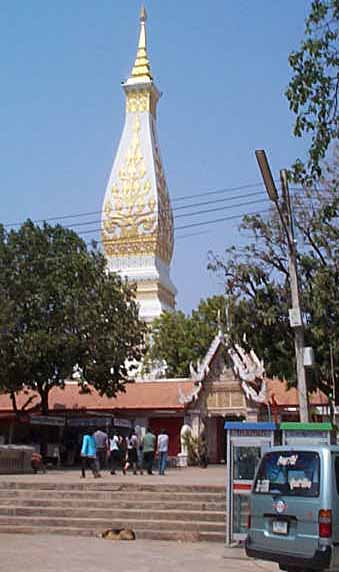
A small structure like the original chedi is located where the old chedi existed.
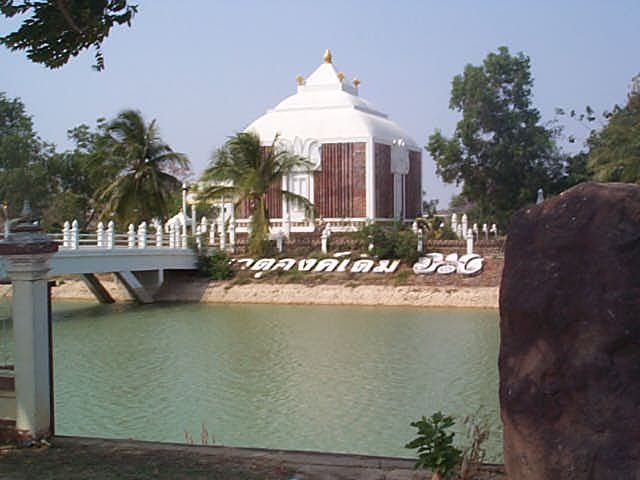 .
.
The Mekong River is now only about 100 meters from the location of the old chedi.
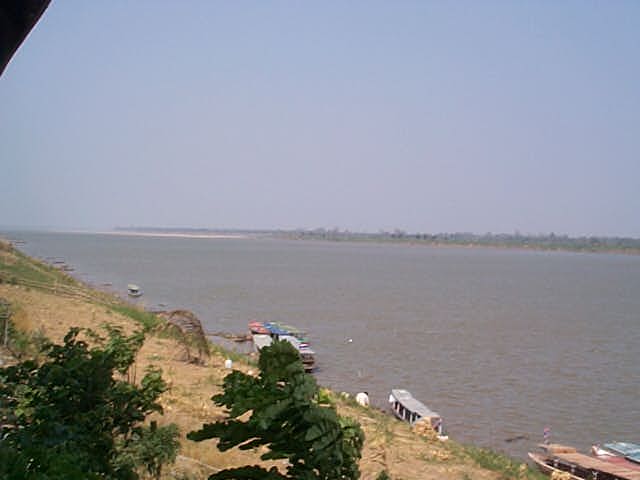
The complex has a lot of things around it, and a museum with old artifacts on display. Some of the things I found exceptionally interesting:
There were some large iron meteorites associated with the chedi. Since I know meteorites well from my professional work in the U.S. space program, I can confirm that yes, those are in fact large iron meteorites on display in the museum. It's also been said that meteorite iron was used to make some artifacts. (Actually, iron meteors consist of an iron-nickel-cobalt alloy, and are not pure iron.)
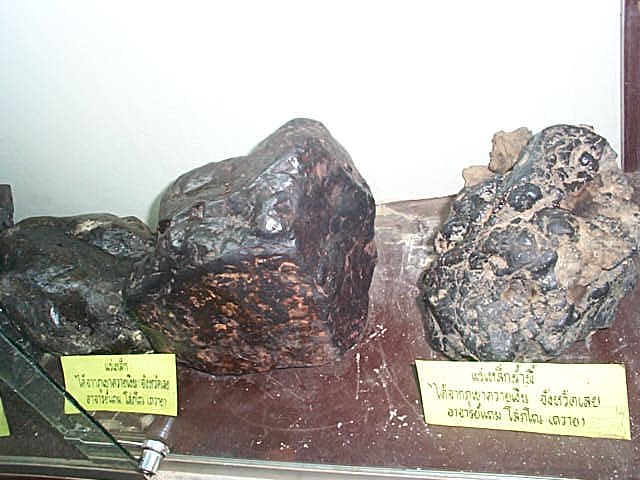
There are a lot of artifacts whose purpose was making sound by striking them. Outside are some very large ones, some of which you are allowed to strike to hear them and imagine doing so in ancient times and environmental ambiance.
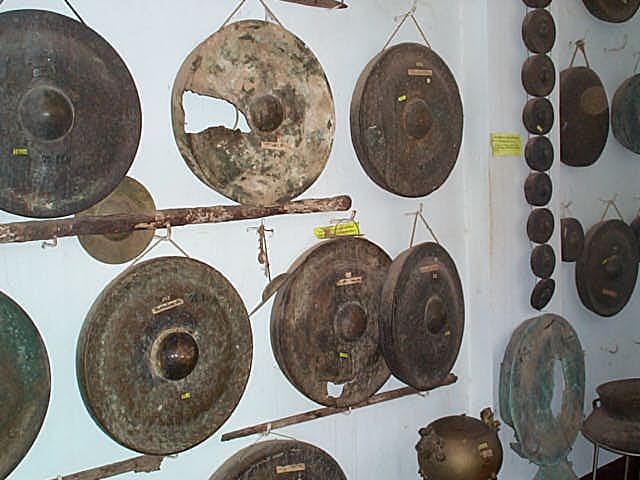
Notably, there were some modern American coins in one section, the kind still in circulation, but not historical ones out of circulation.
Leave a voluntary donation in the museum box as you leave.
Outside, one of the Buddhas seemed to have the quality of always looking at you. Even in the photo and at my angle. Behind the Buddha's head is the wheel of change and impermanence, and to me the tree reaching out over the Buddha symbolized the cobras that made an umbrella to protect the Buddha.
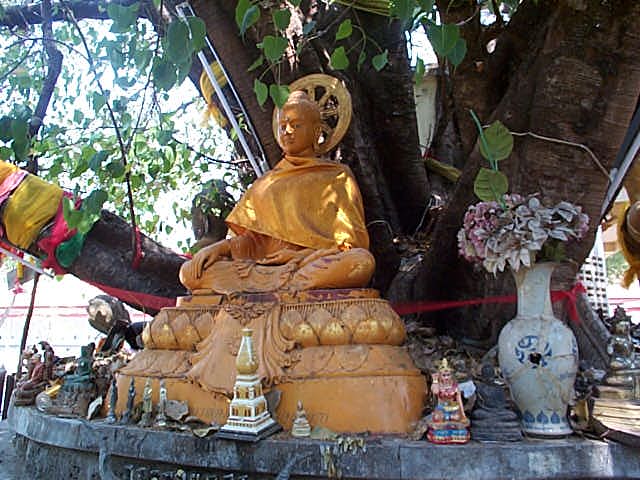
I returned from this long sojourn nearly broke in the pocket but spiritually renewed.
Here are a few photos of the usual ritual when you come into the chedi complex:
First, you get a lotus flower bud, an incense stick and a thin gold leaf wrapped in paper. If you're not familiar with this ritual, here's what you do, steps two thru five.
Secondly, you go to the flame to light the incense. In this case, its encased in an elevated metal box which protects it fairly well from the wind, though I was amazed that it was still lit because it was only a candle and the box was simple.
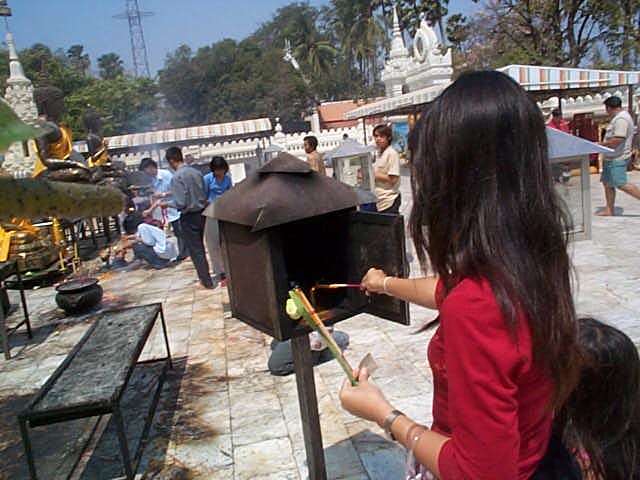
Third, you meditate for a moment. Many people make a wish. For example, I wished (or willed) for a good life for my daughter, pictured with my wife.
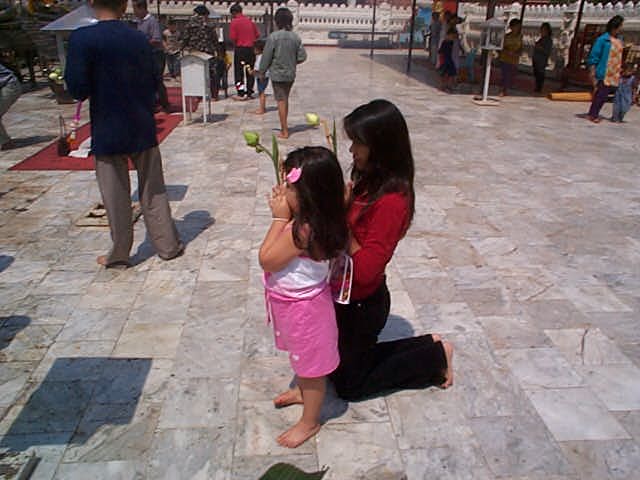
Fourth, you place the lotus wherever you wish, and the incense into a holder.
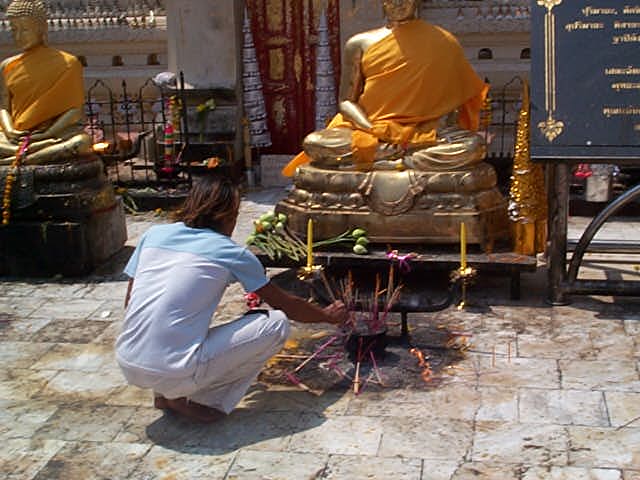
Fifth, you take the gold leaf and rub it onto a metal Buddha. It doesn't stick easily. What I do is put the gold in contact with the Buddha and the paper on top, and then scratch on the paper, which is effective in bonding the gold to the metal Buddha. You can see in the close-up photo that many gold leafs aren't attached very strongly.
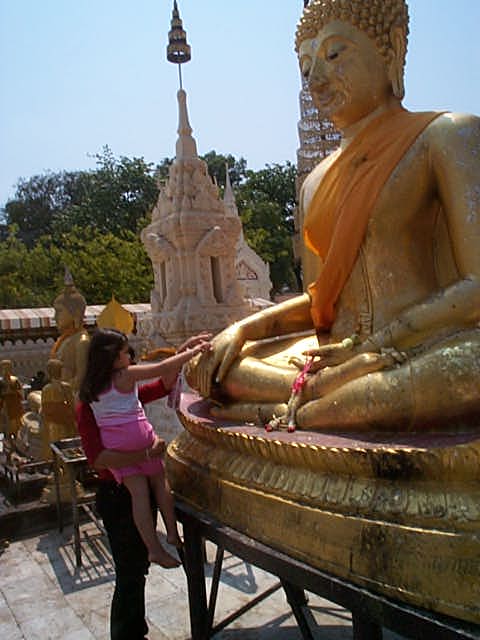
and
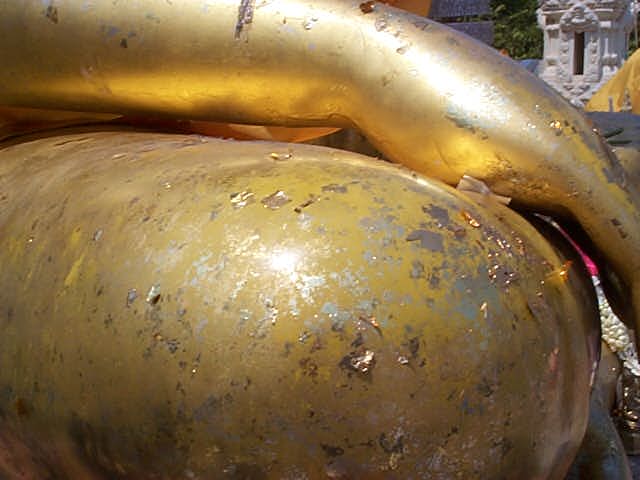
There are also a couple of vendors walking around the complex with birds in cages. This is a custom whereby you carry a bird in a cage around with you as you contemplate things in the complex, and in the end let the bird free. I don't know the price, but here's a photo of the vendor, below. Not many people do this, but it's worth mentioning because visitors must wonder what those vendors are trying to sell.
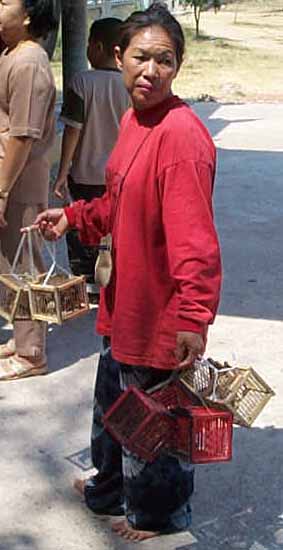
You can find some very old and large bricks laying around, which were construction materials from the old chedi.
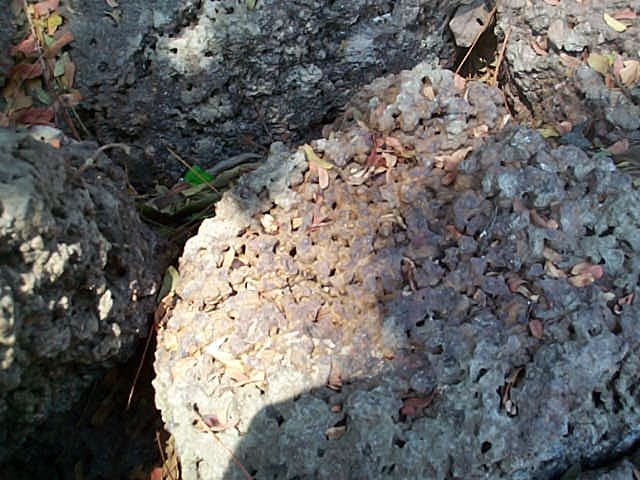
Finally, some scholars have called into question the original construction date. Did the Buddha really come to this part of the world? Nakhon Phanom is a very large distance from Nepal, over rugged land routes or by sea and then up the treacherous Mekong River. The Buddha and his disciples obviously spread the teachings very wide and far, and it's remarkable that one man from so long ago had such a great impact on this part of the world.
Read also about the lost civilization of Ban Chieng, the world's oldest known bronze-making civilization (according to fairly recent archaeological discoveries), located in northeast Thailand from 4700 to 3500 years ago (2700 to 1500 B.C.), in comparison to the Buddha's time 2544+ years ago (543+ B.C.).
 > Domestic Travel for Leisure > Nakhon Phanom Chedi
> Domestic Travel for Leisure > Nakhon Phanom Chedi
Copyright 1999 -
2025 by Mark Evan Prado, All Rights Reserved.
Notably, I get quickly notified of copies of tracts by the CopyScape / CopySentry automatic search engine & notifier.
Short quotes are often OK and can be approved, if there is a clear reference and web link back to my website from the quoted material, and if you send me a short message. I try to help people with good intentions, and try to help the world. Not thieves. Links back to this website are helpful for sustainable progress, thank you!
Please have honor and class by following intellectual property and internet protocols. Be a good kind of person in life.
|
Want to privately ask the Thailand Guru? Contact us.
|
|
Some of the services discussed on Thailand Guru are provided by our friendly staff in our 2 companies: |
|
|
Lucky Lion Pride Co., Ltd.
|
|
| DISCLAIMER: Although efforts have been made to ensure the information on this website was correct at the time of electronic publication, ThailandGuru and all its associates do not assume and hereby disclaim any liability to any party for any loss or damage caused by errors, omissions or misleading information resulting from negligence, accident or any other cause. If you choose to take any of this advice, it is at your own risk and no other entity's. ThailandGuru and its associates will take no responsibility. The only thing we guarantee is that our website information can take bandwidth, memory and/or disk space, at least temporarily. Guru is relative. | |
Menu: Site Map
